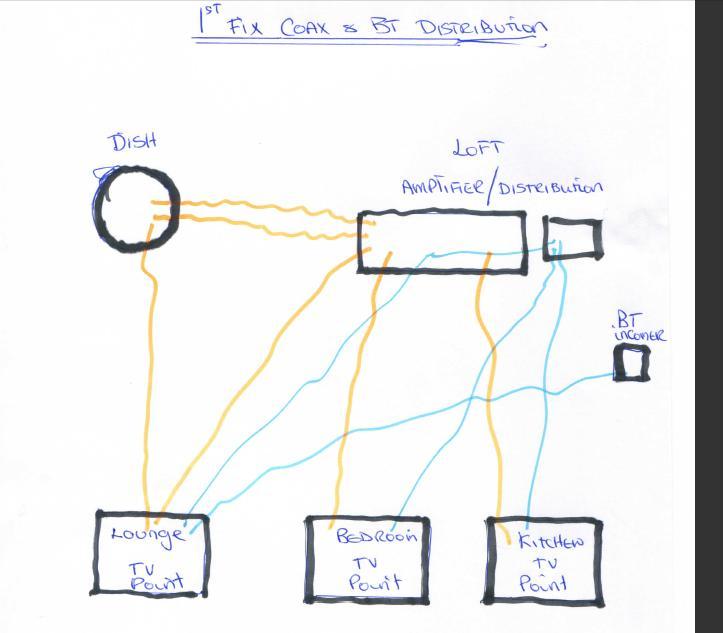As above, use WF100 rather than 65 shotgun - the losses are less which will be an issue once the next bit comes in ...
Decide on a central point, which appears to be what you've almost done. Take all your antenna (satellite, UHF, VHF, DAB) to there along with your phone service. Run multiple cables (coax and "cat5"*) to each point you may want it - I'd say 2 coaxes to most points, 3 or 4 to the main TV, and 3 cat5 to each point, 4 to the main TV. Where did those numbers come from ?
It needs 2 coaxes to service a satellite devices with twin tuners (Freesat+, Sky+, TVs with PIP or recording ability). At the main TV point (where most people put their Sky+ box) it's better if you have a separate cable for the RF return to the rest of the house if you go that way and another for the UHF/VHF/DAB - saves muxing Sat and Terrestrial down one cable.
You can use a Cat5 cable for the phone, but not vice-versa - so in general I don't think it's worth putting in "phone" cable (which should be CW1308 spec). You'll want at least one network connection for each point given how much stuff is networked these days - and you have the chance to do it with cable now which is better than WiFi any day for this sort of thing (anyone who says otherwise is an id10t or just lying).
Lastly, you can run HDMI over Cat5/6 - but the better units need two cables, one cable imposes some limitations. So rather than use RF to feed your Sky round the house (at really crap quality by todays standards), you could use HDMI extenders/switching system to pipe decent signals round the house
Of course, far better still, and achievable with some planning in most houses, is to simply may provision to pull more cables in later. The trick is to put some work in - use conduit (the wide flat oval type normally) and don't do the normal trick of stopping it short of the box - so plaster blocks the last half inch ! Enlarge the holes in the standard back boxes (a "nibbler" tool is good for this) so that the conduit finishes more or less flush with the inside surface of the box. Then usually it's a case of making sure you can get a selection of floor boards up in order to get access in future.
Not always possible, but in most "traditional" types of house it should be.
* "Cat5" in general conversation usually means Cat5e as most people (myself included) can't be bothered saying/writing the "e" all the time ! You can of course use Cat6 which is a higher spec cable and slightly more future proof.



